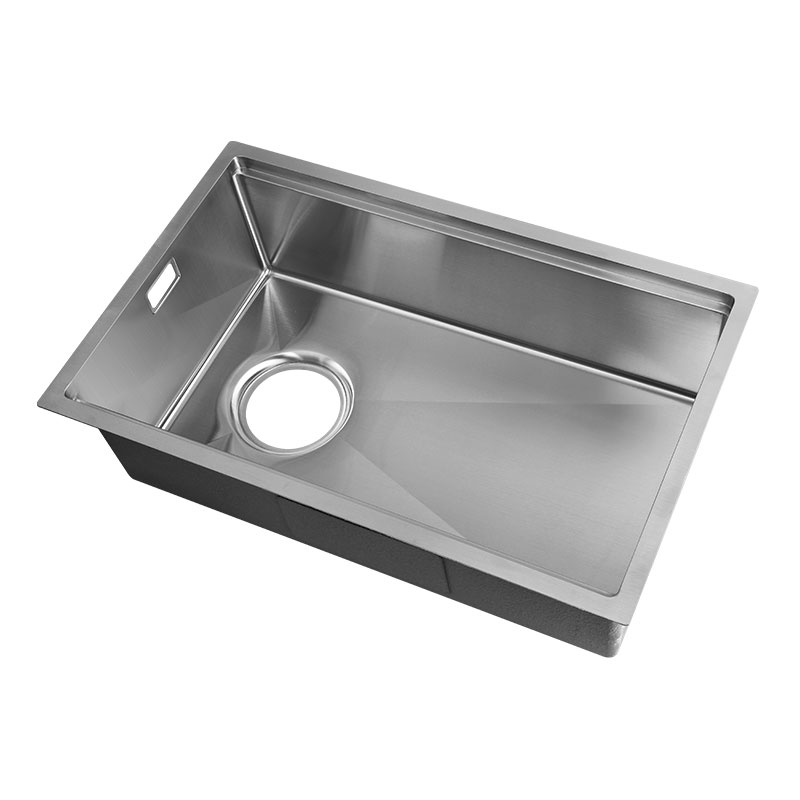

The Kitchen Handmade Sink is a handcrafted stainless steel kitchen sink made from high-quality 304 stainless steel and meticulously crafted. Its unique design and exquisite workmanship provide users with a practical and aesthetically pleasing kitchen cleaning solution. This sink not only meets daily kitchen cleaning needs but also adds a refined, handcrafted touch to any kitchen space.

1. High-Quality 304 Stainless Steel
The Kitchen Handmade Sink is made of 304 stainless steel. 304 stainless steel is a high-quality material widely used in food processing and kitchen equipment, effectively resisting corrosion and oxidation from daily use. Compared to ordinary carbon steel sinks, 304 stainless steel sinks have a lifespan 3-5 times longer, ensuring they maintain their excellent appearance and performance even after extended use.
2. Single-Bindle Design
The sink features a single-basin design measuring 800mm × 450mm × 200mm, providing ample washing space. The single-basin design easily accommodates large items such as pots and pans, making it convenient for various washing tasks. Furthermore, the single-basin design creates a simple and elegant appearance, adapting to various kitchen decor styles and enhancing the overall aesthetic of any kitchen.
3. Handcrafted Craftsmanship
The Kitchen Handmade Sink is handcrafted, with each piece meticulously crafted by artisans. Handcrafting ensures meticulous attention to every detail of the sink, including the rounded edges and smooth surface. Compared to machine-made sinks, handcrafted sinks achieve a surface smoothness of less than 0.5 μm, significantly exceeding the 1.0 μm of machine-made sinks. This creates a more delicate feel and a superior user experience.
4. Durability
The sink's 1.2mm thickness and uniform board thickness provide exceptional durability and resistance to deformation. The rounded edges, with a radius of 3-5mm, prevent sharp scratches on hands and utensils, while also enhancing the overall durability of the sink.
5. Easy to Clean
The sink's surface undergoes a special polishing process, resulting in a smooth, even finish that resists stains and water spots. Daily cleaning requires only a gentle wipe with a damp cloth to remove dust and stains. For stubborn stains, a mild detergent and a soft cloth can easily restore the sink's finish. Compared with ordinary stainless steel sinks, cleaning efficiency is increased by 40%-50%, and cleaning time is shortened to one-third of the original, greatly reducing the user's maintenance workload.
1. Home Kitchen
In the home kitchen, the Kitchen Handmade Sink is an ideal cleaning hub. Its single-basin design and large capacity easily accommodate a variety of large pots and dishes, such as baking trays and large stockpots, for centralized cleaning. Users report that using the sink reduces the time spent washing large utensils by approximately 40%, significantly improving kitchen efficiency.
2. Commercial Kitchen
In commercial kitchens, the Kitchen Handmade Sink is designed to withstand the rigors of heavy use. Its durable 304 stainless steel construction and single-basin design make it suitable for the frequent cleaning and disinfecting required in commercial kitchens. According to industry data, the average lifespan of a stainless steel sink in normal use in commercial kitchens is 10-15 years.
3. Café Bar
In the café bar area, the Kitchen Handmade Sink provides a convenient cleaning solution for baristas. Its single-basin design easily accommodates various components of the coffee machine, such as the dripper and steam wand, making daily cleaning and maintenance easier. According to café operational data, using stainless steel sinks improves bar cleaning efficiency by approximately 25%. Furthermore, the sink's smooth surface and easy-to-clean features allow baristas to quickly remove coffee residue and milk stains, keeping the bar area clean and hygienic, and providing a comfortable environment for customers.
4. Dessert Shops
In the dessert shop's operating area, the Kitchen Handmade Sink can be used to clean various baking tools and small utensils, such as whisks and mixing bowls. Its single-basin design and convenient size allow pastry chefs to easily perform cleaning tasks while keeping the work area tidy. Based on actual usage in dessert shops, this sink effectively improves dessert-making efficiency and reduces downtime caused by cleaning.
1. Daily Cleaning
We recommend performing a basic cleaning of your sink after each use. Use a soft, damp cloth or sponge to wipe the inside and outside of the sink, focusing on the bottom and drain area. Rinse thoroughly with clean water and wipe dry with a dry cloth to avoid residual moisture that can cause water spots or stains. Regular cleaning can keep your sink's surface pristine and extend its lifespan by 20%-30%.
2. Avoid Using Strong Acids and Alkalines
When cleaning, avoid using strong acidic or alkaline detergents, as these can corrode the protective film on the sink surface and damage the stainless steel. For stubborn stains, use a neutral detergent and a soft cloth, or a specialized stainless steel cleaner.
3. Regular Disinfection
To maintain sink hygiene, it's recommended to disinfect the sink monthly. Use a diluted bleach solution or a specialized kitchen disinfectant to wipe the inside and outside of the sink, especially around the drain and seams. After disinfection, rinse thoroughly with clean water and wipe dry with a dry cloth.
4. Avoid Extreme Temperature Shocks
When using a sink, avoid sudden extreme temperature shocks, such as placing hot pots and pans directly into the sink or pouring large amounts of ice water directly into the sink. These sudden temperature changes can increase thermal stress on the sink surface, affecting its durability. It is recommended that when handling high- or low-temperature items, they be placed on a heat-resistant pad before cleaning.
5. Regularly Inspect the Support Structure
In addition to inspecting the sink itself, you should also regularly inspect the sink's support structure and mounting components, such as the sink brackets and mounting screws. The stability of these components directly affects the sink's lifespan and safety. It is recommended to inspect them every six months to ensure that all supporting structures are secure and not loose.